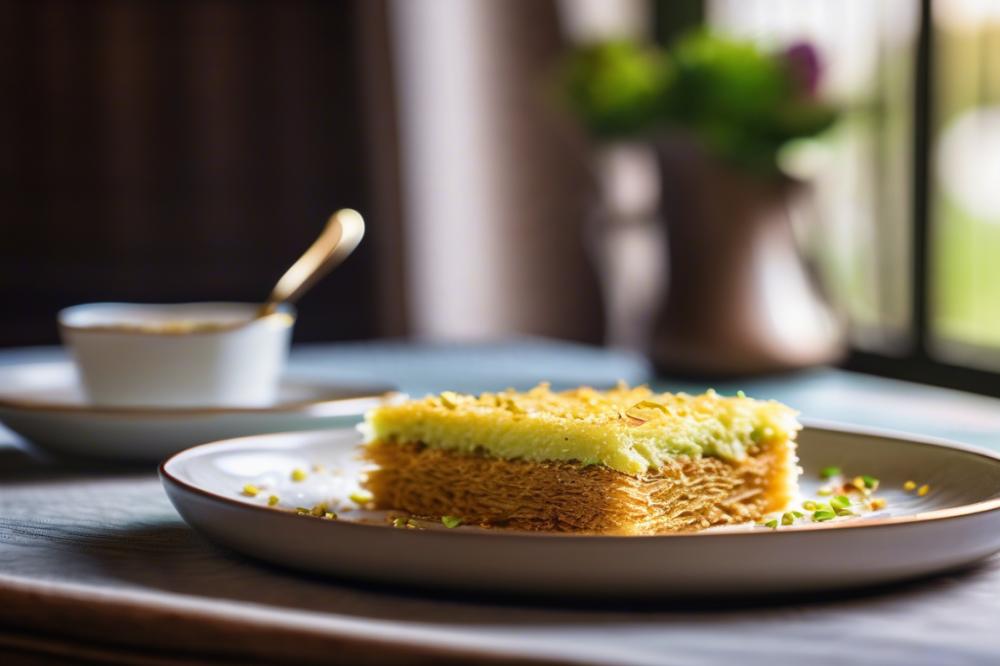Introduction
Greek desserts are renowned for their rich flavors and unique textures. Each sweet treat tells a story, often rooted in age-old traditions and family recipes. Among the many delights from Greece, none is quite as intriguing as kataifi pastry. This dessert captures the essence of Mediterranean flavors through its innovative use of thin strands of dough and fragrant syrups.
Kataifi is a beloved festive dessert in Greek cuisine. Fluffy strands of the kataifi pastry create a nest-like structure that cradles a luscious filling of finely chopped nuts. Traditionally, pistachios are often chosen for this recipe, adding a subtle crunch and vibrant color. As the dessert bakes, it soaks in a sticky syrup made from honey and sugar. This results in a treat that is both sweet and aromatic, captivating the senses.
Embracing traditional recipes is vital in celebrating Mediterranean culinary history. They connect generations, showcasing the importance of regional ingredients and cooking methods. As families gather around tables filled with various Greek sweets, they maintain culinary customs that have been passed down through time. The heart of these recipes lies in their simplicity yet complex flavors. Such traditions keep the spirit of places alive, reminding us of home and heritage with every delightful bite.
Whether enjoyed during holidays or as an everyday snack, Greek Kataifi remains a beloved choice. This Pistachio Dessert exemplifies the richness of Greece’s dessert culture, combining taste and tradition in every layer.
Greek Kataifi: An Overview
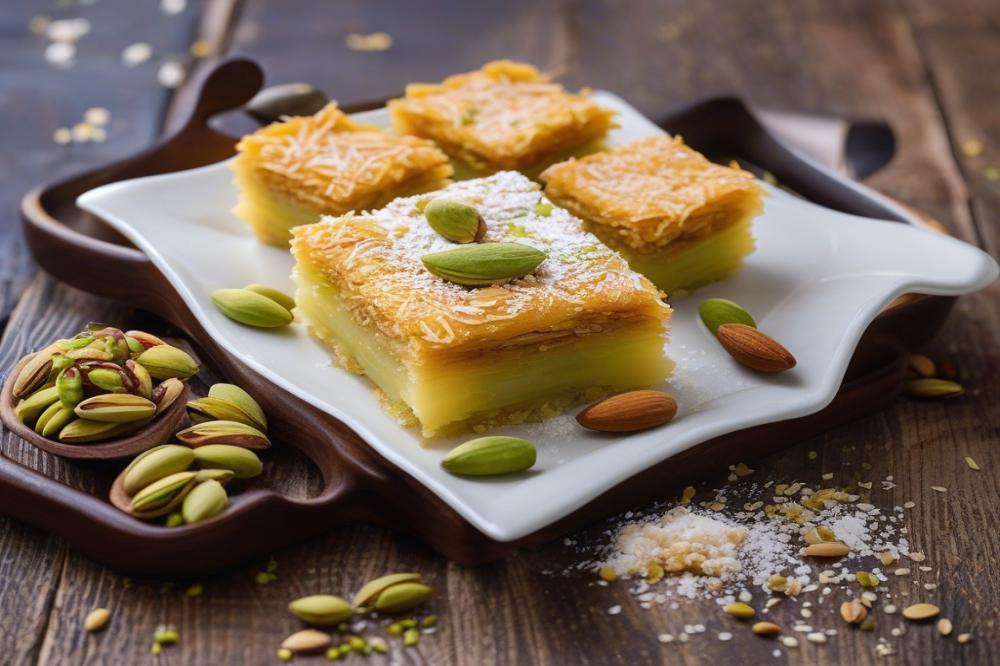
Kataifi pastry is a special type of dough that resembles thin strands of spaghetti. It is made from shredded phyllo dough, giving it an airy and delicate texture. This pastry serves as the foundation for many delicious desserts, particularly in Mediterranean cuisine. When filled with nuts, especially pistachios, and drenched in syrup, kataifi transforms into a mouthwatering treat.
The history of kataifi in Greece dates back centuries. This dessert reflects the rich culinary traditions of the country. It often appears during festive seasons, symbolizing celebration and hospitality. Families take pride in their traditional recipe, often passed down from generation to generation. Preparing kataifi can be a communal activity, bringing together friends and loved ones.
Cultural significance shines through with this beloved dish. It represents not just a dessert but also a connection to heritage and family gatherings. People enjoy it at weddings, holiday feasts, and special events. The sweet aroma of kataifi being baked fills homes with warmth and nostalgia.
Variations of kataifi are plentiful in Greek sweets. Some recipes incorporate a blend of different nuts, enhancing flavors. Others play with the type of syrup, using honey or adding a hint of orange blossom for extra depth. Chefs enjoy experimenting, showcasing creativity while honoring tradition. Each style offers a distinct taste, highlighting the diversity of Greek cuisine.
The harmony of crispy pastry and sweet syrup creates an unforgettable experience. This Mediterranean dessert delights with each bite. As families continue to make kataifi, its legacy lives on, ensuring that future generations will also cherish this unique treat.
Ingredients and Measurements
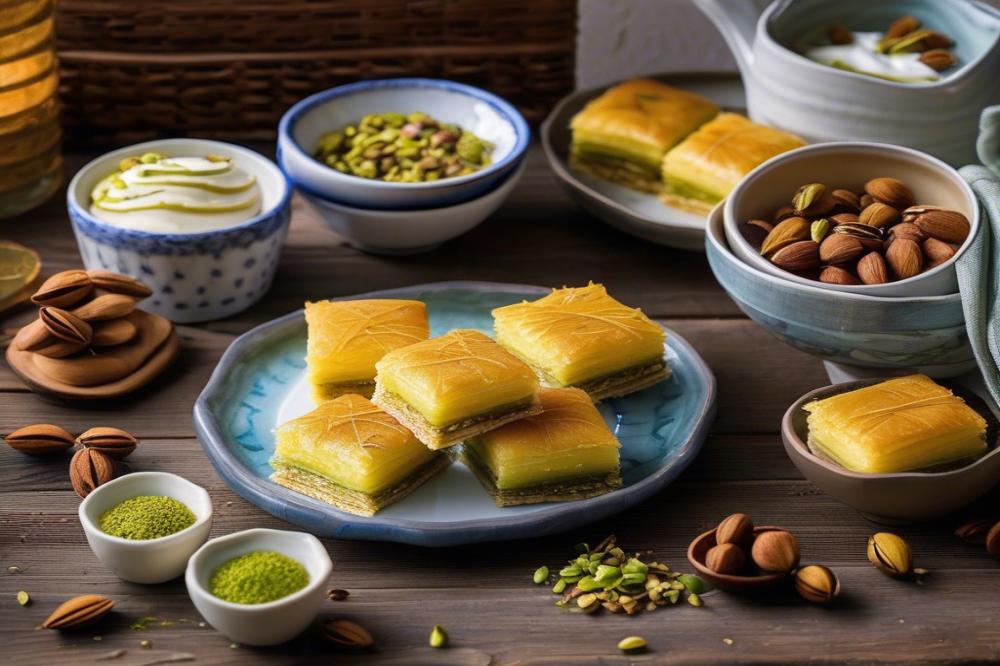
To craft the beloved Mediterranean dessert that is kataifi, you’ll need a selection of carefully measured ingredients. This traditional recipe highlights the unique flavors of each component, creating a festive dessert perfect for any occasion.
- Kataifi pastry – 500 grams
- Unsalted butter – 150 grams
- Coarsely chopped pistachios – 200 grams
- Sugar – 200 grams
- Water – 300 ml
- Honey – 100 grams
- Vanilla extract – 1 teaspoon
- Lemon juice – 1 tablespoon
Each ingredient contributes to the final outcome, both in flavor and structure. The kataifi pastry serves as a base, its fine strands creating a texture reminiscent of phyllo dough. Unsalted butter enriches the mixture, lending a smooth mouthfeel and deep flavor. Coarsely chopped pistachios add crunch and a nutty essence that complements the sweetness of the syrup.
Nutritional Information
Understanding the nutritional profile of these ingredients can enhance your appreciation for this dessert. Here’s a quick breakdown:
- Kataifi pastry: 500 grams contains approximately 2000 calories, with 280g of carbohydrates and 25g of protein.
- Unsalted butter: 150 grams has about 1070 calories, providing 117g of fat and negligible carbohydrates.
- Coarsely chopped pistachios: 200 grams contributes around 900 calories, consisting largely of healthy fats, with approximately 70g of fat, 30g of protein, and 40g of carbohydrates.
- Sugar: 200 grams adds about 800 calories, primarily from carbohydrates (200g), with no protein or fat.
- Water: 300 ml contains zero calories, vital for dissolving sugar and creating syrup.
- Honey: 100 grams has roughly 300 calories, delivering 80g of carbohydrates and trace amounts of other nutrients.
- Vanilla extract: 1 teaspoon carries around 12 calories, mostly from carbohydrates.
- Lemon juice: 1 tablespoon has only 4 calories and provides vitamin C.
This nutritional overview helps to contextualize the flavors of this classic sweet. When combined, these ingredients create a delightful treat that embodies the spirit of Greek sweets. Enjoying kataifi topped with honey syrup will surely bring a taste of the Mediterranean to your table.
Cooking Instructions
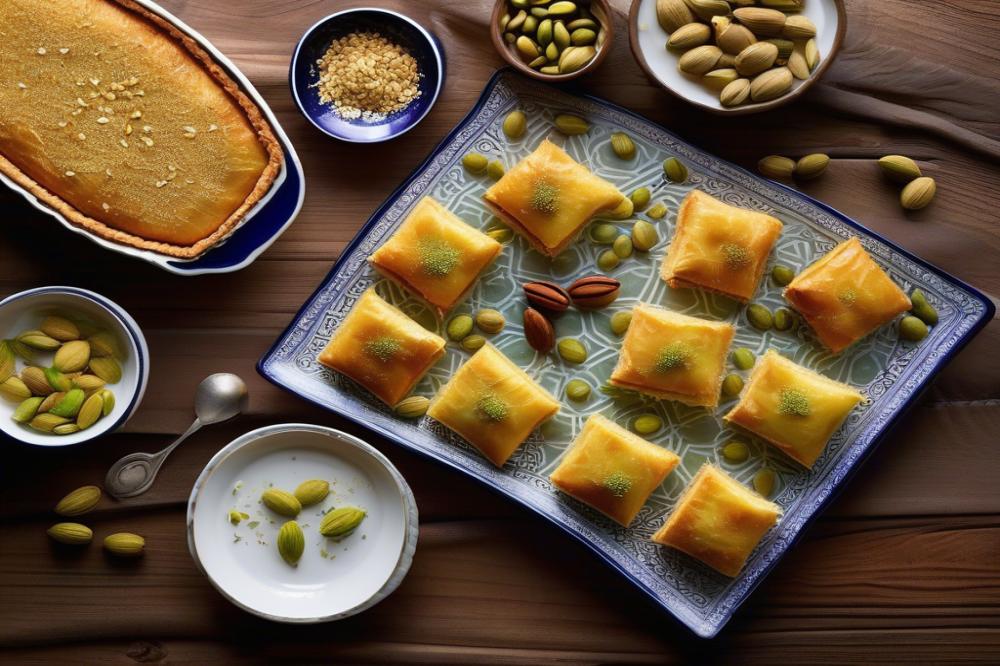
Preparing the Kataifi Pastry
The first step involves working with kataifi pastry. This shredded dough is essential for achieving the right texture. Begin by gently separating the strands. Use your fingers to fluff it, making it lighter and airier. If you can’t find kataifi, you can substitute with shredded phyllo dough. However, this may alter the final result.
Making the Filling with Pistachios
Next, it’s time to create the filling. Start with a generous amount of chopped pistachios. Combine these nuts with sugar and a dash of cinnamon for added flavor. Consider adding a hint of vanilla extract as well. This mixture lends a delightful taste to the Mediterranean dessert. Mix all the ingredients until well combined. Set this aside for later use.
Assembling the Dessert
Now, move on to assembling the kataifi. Take a portion of the kataifi pastry and spread it out. Spoon some of the pistachio filling onto the center of each section. Carefully roll the pastry around the filling. Make sure it’s snug but not too tight, allowing room for expansion during baking. Place each rolled pastry piece in a greased baking dish.
Baking the Kataifi Until Golden Brown
Baking is a key step in achieving perfect texture. Preheat your oven to 350°F (175°C). Bake the assembled kataifi for about 30-40 minutes. Keep an eye on them; you want a beautiful golden brown shade. This color indicates that the pastry is crispy and ready for the next step.
Preparing the Syrup and Soaking the Kataifi
While the kataifi is baking, it’s important to prepare the syrup. In a saucepan, combine sugar and water, bringing it to a boil. Add honey for sweetness and a traditional touch. Allow this syrup to simmer until it thickens slightly. Once the kataifi is out of the oven, immediately pour the warm syrup over the hot pastry. This soaking process enhances flavor and moisture, making the dessert irresistible. Let it sit for a while so the kataifi absorbs all that delicious syrup.
Serving Suggestions
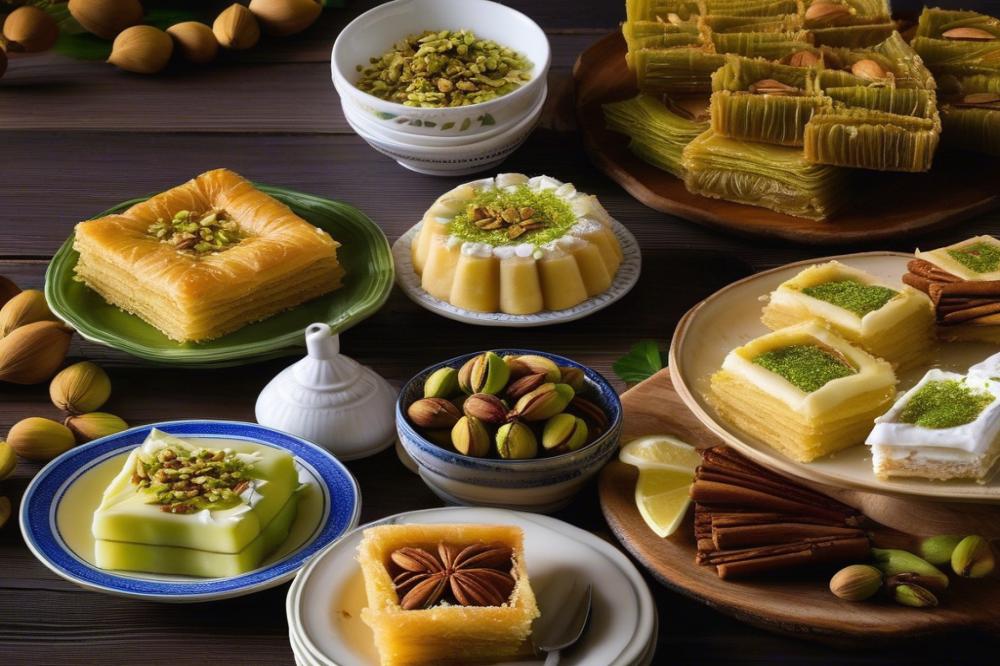
How to Serve Greek Kataifi
The traditional recipe for kataifi pastry is best enjoyed warm. Slice it into manageable pieces for serving. A drizzle of syrup over the top enhances the flavors. Plating it on a nice dessert dish adds to its charm. Consider using colorful plates to create a visually appealing presentation. This Mediterranean dessert looks inviting when paired with additional toppings.
Pairing with Beverages
To enhance the experience, pair this sweet treat with a hot beverage. Many people enjoy it alongside a strong Greek coffee. The rich taste of coffee contrasts nicely with the sweetness of the dessert. Alternatively, a cup of herbal tea can offer a soothing balance. Experiment with flavors like chamomile or mint for added variety.
Garnishing Ideas
Garnishing is a wonderful way to elevate the dish. Try sprinkling extra pistachios on top for added crunch. Crushed nuts can create an appealing texture. A light drizzle of honey can also enhance the dessert’s flavor. For an extra touch, consider using a flavored syrup, like rose or orange blossom. These garnishes make the festive dessert even more delightful and appealing.
Variations and Adaptations
When it comes to the traditional recipe for Greek Kataifi with Pistachios, there are various ways to make it uniquely your own. Flavor is king in Mediterranean desserts, and nuts can significantly change the experience. Almonds, walnuts, or hazelnuts serve as great alternatives. Each nut brings its own character, making the dessert feel fresh and exciting.
Sweetness levels also matter. Some may prefer their kataifi on the sweeter side, drenched in syrup and honey. Others enjoy a more balanced taste. Adjusting the amount of sugar in the syrup or even adding a splash of citrus can make a big difference. A hint of lemon or orange juice can cut through the sweetness, providing a delightful contrast.
Dietary Considerations
For those who follow specific diets, adaptations are possible. Creating a gluten-free version is simpler than one might think. Using gluten-free phyllo dough allows everyone to enjoy this delicious treat. Many stores carry it, ensuring accessibility for all.
Moreover, vegan adaptations are now quite popular. By replacing butter with coconut oil or a plant-based alternative, the dish remains delicious without compromising ethics. Choosing maple syrup instead of honey can cater to vegan diets as well, maintaining the essence of this festive dessert.
The Importance of Syrup in Greek desserts
Syrup plays a vital role in Mediterranean desserts. It adds sweetness, moisture, and depth. For many, the rich flavors in dishes like Greek sweets are tied closely to syrup. Without it, desserts may taste bland or dry.
In kataifi, syrup enhances the flavors significantly. The toasted nuts and spiced layers of the kataifi pastry come alive when drenched in syrup. As the syrup seeps into the pastry, it balances the nuttiness of the pistachios with its sugary essence. This unison of textures and flavors is part of what makes kataifi such a beloved festive dessert.
Traditional Syrup Recipes
Many traditional recipes call for simple yet effective syrup mixtures. A common base includes water and sugar. Adding a splash of lemon juice helps maintain clarity and balance the sweetness. Some recipes incorporate honey for an extra layer of flavor. The result is a light syrup that enhances taste without overpowering the dessert.
After preparing the kataifi pastry, pouring warm syrup over the dish is essential. This step allows the syrup to absorb into the layers, ensuring a moist and flavorful treat. While the dish cools, the syrup thickens and creates a glossy finish, showcasing the intricate strands of phyllo dough and the vibrant green of the nuts.
Whether used in individual servings or larger platters, syrup’s role in Greek desserts cannot be overstated. It transforms a simple creation into a celebration of taste, especially during holidays and family gatherings. Indeed, the luscious blend of syrup and crispy pastry creates a dessert experience like no other.
Final Thoughts on the Traditional Recipe
In summary, creating the cherished Greek Kataifi with pistachios involves layering delicate strands of pastry, nuts, and sweet syrup. This traditional recipe captures rich flavors and textures, combining the crunch of nuts with the soft sweetness of syrup-soaked strands. Each bite tells a story rooted in history and culture, reminding us of the importance of passed-down culinary traditions.
Enjoying Greek sweets is not just about taste; it’s about connecting with a heritage steeped in devotion and craftsmanship. Preserving these recipes allows future generations to experience the warmth of family gatherings and festive celebrations that often center around homemade desserts. There is something truly special about indulging in these treats that evoke nostalgia and love.
With all this in mind, consider giving Kataifi a try in your own kitchen. Making this delightful dessert at home can be a rewarding experience that brings both joy and a sense of accomplishment. Whether you’re hosting friends or simply treating yourself, preparing this dish connects you with a timeless tradition. So, roll up your sleeves, gather your ingredients, and embark on an adventure into the world of Greek pastry!

